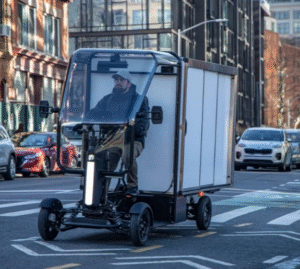SVR’s New Report Analyzes the Trends & Outlook for Golf Car-Type Vehicles Over the Next 5-8 Years
The outlook for golf car-type (GCT) vehicles is quite positive. Small Vehicle Resource, LLC has announced its latest study of the market, including personal transportation vehicles, low speed vehicles, light duty utility vehicles, and fleet golf carts. This study and analysis will be available late this month.
Critical turning points in industry and market development
The market for GCT vehicles is potentially on the threshold of really exciting prospects. Here are some of the key elements that could drive double digit growth in the consumer and commercial segments.
In the consumer channel:
• Growing consumer acceptance of GCTs, especially electric-powered vehicles, as a viable and desirable alternative (or complement) to conventional automobiles;
• The list of cities and municipalities that are allowing GCT vehicles, particularly the certified low speed models, on public roads and streets appears from all indications to be growing;
• Electric GCTs fit well into the climate change strategies of many urban and suburban areas:

• GCT vehicles are at the threshold of market development merging onto a stage of rapid growth or take-off;
• In short distance driving (5-7 miles or less) low speed vehicles could well become the dominants means of mobility;
• Fueling the positive changes of consumer preferences are the on-going upgrades in GCT vehicles featuring automotive-type accessories and attributes; e.g., power steering, backup cameras, four wheel disk brakes, and even autonomous driving systems.
In the commercial channel:
• Higher powered electric motors will allow most diversified use of GCT utility vehicles;
• Solid potential for use in the last mile delivery market, surpassing in performance electric cargo bikes and other types of cargo delivery option;
• Both Club Car and E-Z-GO carry utility vehicles in their model lineup that
• Aggressive new market strategies will be required to exploit the last mile delivery segment, as new entrants, such as Honda are involved in
Both segments are rapidly moving into the e-mobility universe. The SVR report presents scenarios of rapid growth. The highly positive outlook has implications for a changing competitive framework with new companies entering the industry.
A good example of a possible new entrant is Honda with its new business division, Fastport. Honda debuted a new business unit named “Fastport” in late June, featuring a four-wheel cargo cycles to serve the last mile delivery market in dense urban areas in North America and Europe.

The quadracycle comes in two load capacity versions, one for a 650 pound load capacity and a lighter duty version with a 350 pound capacity. Note that the target markets are densely populated cities in North America and Europe.
Honda’s strategy has two key elements: First, it focuses on dense, urban environments that already have incorporated e bikes of all sorts into their transportation systems; and secondly, have developed an e-scargot bike version that is four-wheeled and thus more robust than two or three-wheeled versions.
Golfcar-type utility vehicles that are currently available on the market can outperform the Honda quadracycle in many ways, but it will take more than a good product to win in this market. In addition there must be a market strategy, and a marketing organization geared to exploit these advantages.
The last mile delivery market is not confined to densely populated urban areas. Suburbs are also a target environment that is being served by my last mile systems, such as provided by DoorDash. The lithium battery-powered LSV is well suited for this market, as well. In all cases, however, residential and business characteristics are unique from one location to another. Nonetheless, the versatile, LSV-certified utility vehicle should find a place in the last mile delivery market over the forecast period.
Tariff uncertainties fully analyzed
Imports of partially assembled GCTs surged in the last half of 2024 in response to impending tariffs imposed on Chinese products and low speed personal transportation vehicles in particular. The result has been a massive runup in inventories.. While currently these units could be held at dockside storage or warehouses, warehouses elsewhere, or with wholesalers and dealers., they will be eventually in the market and sold off.
The SVR report deals fully with this issue and its potential impact on the market. The report analyzes both the process of excess inventory sell-off and the price reductions that will be needed to incentivize sales.
New companies and technologies will define a highly dynamic market
The SVR report makes the further case for market expansion over the next eight years with the ambitious introduction of a variety of new transportation and delivery systems—all of which are conducive to the use of GCT vehicles. And major companies are involved; for example, Honda, as cited above, Walmart with its drone systems and “dark” stores, Tesla and others with robotic, self-driving vehicles. In addition, there are a number of lesser-known start-ups pushing the envelope, such as Fernhay in the U.K. and globally-based Interoll (microhubs).
The bottom line is that the combination of the consumer-oriented short distance driving market and last mile delivery systems offer a highly dynamic environment geared for growth for GCT vehicles. The new SVR report and analysis will provide a strategic working paper for industry participants and investors.
________
Contact the Author: Steve Metzger at smetzger@smallvehicleresource.com. Or check out our website at www.smallvehicleresource.com, where you will find an extensive database of vehicle models and can make side-by-side comparisons of vehicles based on a full set of specifications.


